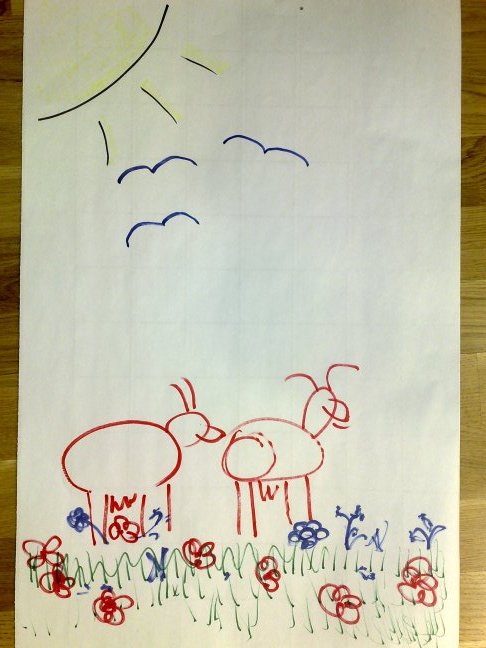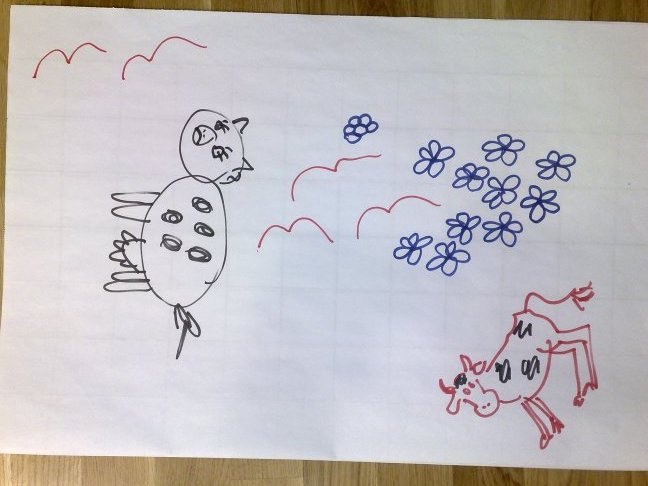Today I held a class in Scrum and Lean.
I was then able to test some of my learnings from the PSL class in a exercises I made up just the day before.
The results were almost too good.
I divided the class in two groups (consisting of about 6 people each) and told them that they in this exercise would do a drawing during silence, following a requirement I would hand out. The would only have one minute to complete the drawing.
I provided them with a number pencils in red, green and blue and one big piece of paper each. Then I handed out one paper with the requirements to each group and started a visible timer counting down 60 seconds.
One of the groups got the following requirement:
Draw a beutiful summer meadow with blue and red flowers in green grass, some cows and birds under a shining sun.
The other group got the following requirement:
Draw a beutiful summer meadow with
- 10 blue flowers with 5 petals each
- 5 blue flowers with 6 petals each
- 13 red flowers with 6 petals each
- 2 cows with 3 black spots
- 1 cow with 5 black spots
- 2 cows with 4 black spots
- 2 birds to reside in the upper left corner
- 3 birds in the middle
- one sun to the right with 5 sun beams
Before reading further, look at there drawings here and guess which drawing was made by which group.


Well, as you might have guessed, the drawing to the left was made by the group that got the open-ended requirements and the drawing to the right was made by the group with a lot of specification detail. And that drawing does’nt even comply to the base requirement; a summer meadow.
And the cows are, although rich in detail, on the wrong angels. – The group behind the right drawing had such focus on implementing every detail of the requirements that they forgot the main purpose of the “assignemnt”, to draw a meadow.
Do you recognize that from software development ? I for certain do, and I do remember how boring it have felt implementing over-specified requirements. I just wanted to get it over with. Which I think is a very natural reaction when you are left with no opportunity for your own creativity. Or worse, find out obscure ways to put in your creativity anyway, in ways that might yeild even worse solutions.
I felt that the class got the same “ah” experience as I did myself on the PSL class.
Once again I have to give my appreciation to Jerry Wienberg, Esther Derby and Johanna Rothman.
The Problem Solving Leadership class continues to make a huge impact on my life.
It is the most expensive class I ever spent my money on in terms of actual swedish kronas, but not a cost but truly profitable in terms of the leverage it has on my consulting.
If you are a consultant like me and work with teams and leaders I think you can do no better investment than attending the next PSL class. It will be held in late march, check it out and click here!




Gee, David, they wasted a whole minute on this exercise. You could have used the time to read at least two bullet points from a powerpoint slide. (just kidding, of course)
What a great exercise. I’m going to steal it, of course. Thanks, Jerry
David, what a great simulation–I love it. I think you’ve captured the difference between a user story (the not highly specified requirement) and functional/non-functional requirements. Way cool!
David – I too attended PSL with Jerry, Johanna, and Esther.. back in 2007! It was an amazing experience, and I’m still integrating things I learned more than a year and a half later. Glad you enjoyed it too!
Your exercise is quite wonderful. If you don’t mind, I would love to use this in my company that is starting to adopt agile practices. I think it would be quite helpful.
I would be curious to hear what learnings the participants had from the exercise.. I find that the sharing portion is often where the magic happens.
Cheers!
Brilliant :o)
I will really be honored if you want reuse my exercise as your own (and no need for referencing me).
And if some of you actually do, what a nice result of 5 minutes of creativity for my part, and which in turn is an effect of several lifetimes of experiences brought to me from the PSL class!
I am so proud that I was in the vincinty that day when you invented this superb exercise.
I like it and will use it as soon as I can. It really captures the essence of ‘over specification’.
At the conclusion of our PSL experience, I found myself wondering what would happen with an exercise like this one. Thanks for trying it out and sharing the results with us!
Steal with pride. I thought about creating an exercise like this for a course I am producing and you gave an excellent example. I will use the idea in the class I am giving in Estonia right now. It will be a good starting point for tomorrow. I will of course let you know the result.
David, I appreciate you for sharing this exercise with all of us 🙂
Hi David,
Trying this and sharing the results is a great act of leadership from you.
I’ll certainly use it.
Best Regards,
Markus
This is cool. I’d owe you the credits when I use it for my class.
I used your exercise and blogged about it. http://www.ryber.se/?p=117 See any similarities between the drawings?
How fun it will be to see meadows in blogs all around the world!
Let us definetely have a conference in Stockholm this spring!
/Tobbe
I too may steal this exercise, but I will aggressively turn down the suggestion to use it without attribution.
Over the last few days, I have seen several instances where people have done disservice to the community in at least one of three ways, and sometimes all three. They have either failed to attribute where ideas have come from (bad enough) and/or they’ve misconstrued the ideas (also bad), and/or they’ve ignored the past and its influence on their work altogether. And it has made me grumpy.
I once got a comment for a presentation at one of the STAR conferences: “Great session, but why do you keep mentioning other people’s names?” Answer: because I think it’s polite, intellectually honest, and terribly important to name and honour the giants upon whose shoulders (or toes) I am standing.
David has done two wonderful things for the community here: he’s shared a terrific exercise, and he’s given credit to the people and the circumstances that inspired it. That’s inspiring. So to me, even if I vary the details, this will always be “an exercise created by David Barnholdt”.
—Michael B.
Hi David,
Wonderful and creative idea! And it worked out so well! Great way to teach people this important insight. I can just imagine being one of those ah-sayers 🙂
Great excercise!
OK, I’ve tried it as well now, thanks David!
Here’s my slightly extended version of this exercise:
https://blog.crisp.se/henrikkniberg/2009/02/28/1235778300000.html
Simply amazing.
Great Job, thanks!
David, I appreciate you for this blog entry. We worked with openended problem definitions also at the PSL in March – I somehow had the understanding, but not the understanding of the application! I thank you for that!
/Carsten 🙂
Hi David,
I finally tried your exercise and it worked perfectly! Brings back a lot of nice memories from our PSL-week.
Cheers!
Hi,
I tried this exercice in France today and it worked very well.
I gave 30 seconds to the teams to read it & to get organized, plus 1 minute to do the drawing. The results are amazing !
Hi,
I also tried this exercice, with 30s for reading and 60s for drawing.
It was fun, short and reveals some crucial elements to the attendees.
Thanks a lot !
Hi, Thanks for this very good idea. I’ve done this game several times now, and each time the result is so obvious! Works very well in order to demonstrate some of the Agile concepts.
Bruno
We recently ran this game for 120 people on 12 tables with a modification for a control audience (e.g. Information Security, Resilience, Legal etc.). The purpose was to demonstrate how early and often engagement with software development is better than detailed written controls and post project audits. With the additional requirements we allowed them 5 minutes in total for the drawing, just long enough to play “What a Wonderful World” by Louis Armstrong twice!
We modified the game to bring in controls for scaling, orientation and distribution.
Scaling – Element of the picture should be on a relative scale, we did not want flowers lager than cows
Orientation – All elements should be the same way up, no upside down flying cows
Distribution – The picture should cover the entire page not be squeezed into the corners or all over to one side
The drawings needed to be signed off by the control functions before the end of the game.
We ran two types of tables
1. Traditional engagement model with detailed requirements and control owners remote from the table, leaving the tables to decide when and if they wanted to engage with the control owners
2. The tables with the vision statement had a control person who actively engages with the tables before they start drawing and constantly throughout the drawing process
We had really good feedback from the audience, they enjoyed the game and more importantly learned about the effectiveness of small multi-disciplinary team with clear vision and frequent control engagement.
David Barnholdt hello, i didn’t know that the ‘Draw a Meadow ‘ excercise is yours, but really it is great, i use it, when coaching team, as an introductory game in story slicing or estimation workshops and really teams like it.